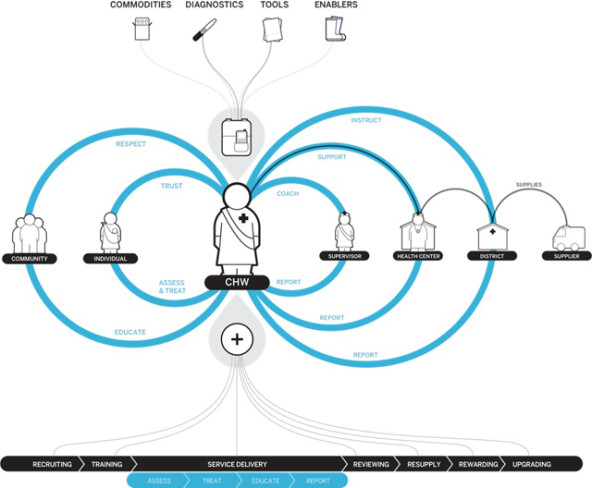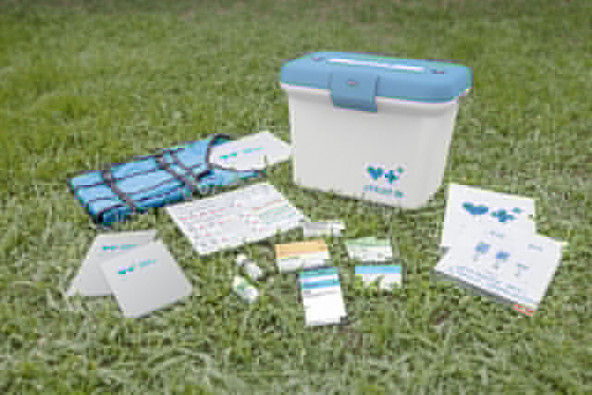 Community health workers demonstrate a storage and inventory management system for commodities, diagnostic tools, and medicines. (Image courtesy of frog design)
Community health workers demonstrate a storage and inventory management system for commodities, diagnostic tools, and medicines. (Image courtesy of frog design)
Despite many challenges, Uganda’s village health teams deliver care to some of the nearly 85 percent of Ugandans who live in remote, hard-to-reach corners of the country, or the “last mile.” During some months, these committed volunteers know that they will have the medicines necessary to treat children dying of pneumonia, malaria, and diarrhea. But during others, the teams are less sure. They’ve also come to expect inconsistent supervision and training.
The situation in Uganda is not unique—community health worker (CHW) programs throughout the world struggle from limited resources and sub-optimal design, often devolving from a national strategy into a patchwork of nonprofit programs and activity.
Why is this? The global health community understands that these same programs are important for reaching Millennium Development Goal 4 (MDG 4)—to reduce mortality among children under five from the current level of 6.6 million deaths per year to 4.3 million by the end of 2015. Yet many perceive CHWs as inadequate replacements for trained health professionals such as doctors and nurses.
We can flip this logic on its head and take a new approach by placing these workers at the center of our design strategies, recognizing that they provide a vital link between communities and the health system. We need a holistic framework that motivates and empowers them.
Are you enjoying this article? Read more like this, plus SSIR's full archive of content, when you subscribe.
At the core of this framework, we would need integrated community case management (iCCM), which offers a systematic approach to delivering and expanding access to life-saving medicines. CHWs form the backbone of this approach; they can ensure that sick and vulnerable populations are correctly diagnosed and treated. If fully funded and implemented, it is estimated that iCCM delivered through CHWs could save up to 250,000 lives by the end of 2015. Accomplishing this would require a few important tools:
- Increased access to commodities, diagnostic tools, and medicines. Specifically, this would need to include malaria rapid diagnostic tests and respiratory timers for pneumonia, artemisinin-based combination therapies to treat malaria, antibiotics such as amoxicillin dispersible tablets for pneumonia, and ORS/Zinc to treat diarrhea.
- A solid community-based service delivery platform. The platform would have front-line CHWs at the center, with the necessary systems support for them to function effectively and efficiently. Support would include training and deployment (including retention and incentives), an effective supply chain that reaches the most peripheral levels, supportive supervision, and monitoring to maintain quality and skills.
With this in mind, in 2012, UNICEF, MDG Health Alliance, and Save the Children reached out to several other partner organizations, including USAID, with the goal of developing a holistic CHW system that could:
- Serve as an assessment tool for existing country-level CHW programs
- Outline a menu of best practices and innovations from across the globe while encouraging idea-sharing
- Empower, recognize, and motivate CHW programs to serve as platforms for programs beyond iCCM—including newborn and maternal health programs
The team partnered with the innovation consulting firm frog design, which engaged more than 60 organizations—including global health experts, private sector corporations, and program implementers across Africa and Asia—and led the team through sessions and immersion exercises in Uganda and Senegal over 12 weeks.
Through research, prototyping, and refining designs, the team uncovered two major opportunities for empowering CHWs (known as Backpack PLUS):
>> A holistic, detailed design of an effective CHW delivery ecosystem, including appropriate recruitment, pre-service and ongoing training, incentive structures, reporting and data collection, supply chain management, and recognition
 A CHW-centric model identifies all the essential physical, digital, and service-level components required to empower CHWs along their journey. (Image courtesy of frog design)
A CHW-centric model identifies all the essential physical, digital, and service-level components required to empower CHWs along their journey. (Image courtesy of frog design)
>> Complementary equipment for countries developing new CHW programs, including a backpack and storage box containing essential medicines and diagnostics, inventory management tools, and training aids. These physical elements must integrate with a common set of visual design standards across different manufacturers and producers to ensure that they are easy to use and support the workflow of CHWs through the typical stages of maternal and newborn care.
 Prototypes of physical products that could support CHWs were developed as part of the project. (Image courtesy of frog design)
Prototypes of physical products that could support CHWs were developed as part of the project. (Image courtesy of frog design)
To move this framework and these tools forward, the team has initiated a comprehensive program called CHW PLUS. The steering committee includes UNICEF, Save the Children, the Bill & Melinda Gates Foundation, USAID, the Office of the UN Special Envoy, the RMNCH Strategy and Coordination Team, members of the CCM Task Force, and the One Million Community Health Workers Campaign. CHW PLUS has three main objectives:
- Mobilizing funding and resources to scale up CHW programs globally
- Overcoming critical bottlenecks on the ground
- Marshalling evidence and sharing best practices to support higher levels of impact based on this CHW delivery ecosystem
While our work is far from done, we hope that this collaboration will further existing efforts in-country by empowering thousands more CHWs and accelerating progress toward MDG 4.
The human-centered design methods that frog introduced encouraged groups to take a fresh look at CHW systems, and to feel comfortable suggesting and even adopting novel approaches to persistent challenges. Bringing in diverse perspectives and a structured design process helped us uncover new solutions to entrenched challenges, and we believe that other global health projects, even other sectors, could benefit from using a similar approach.
Support SSIR’s coverage of cross-sector solutions to global challenges.
Help us further the reach of innovative ideas. Donate today.
Read more stories by Robert Fabricant, Claire Qureshi & David Milestone.

